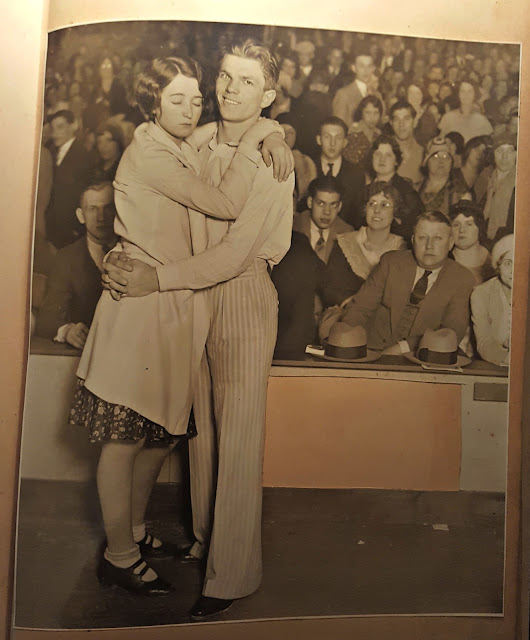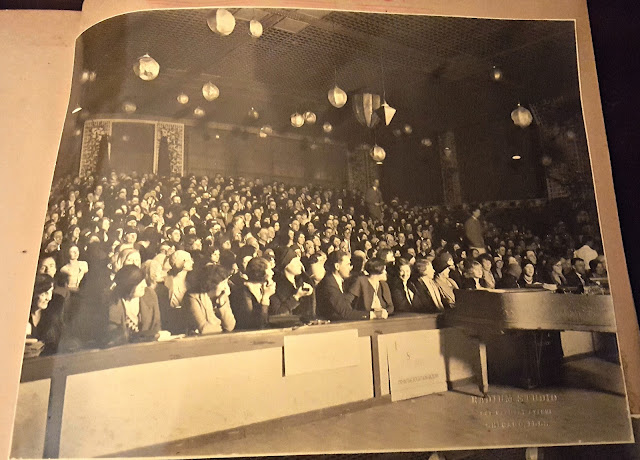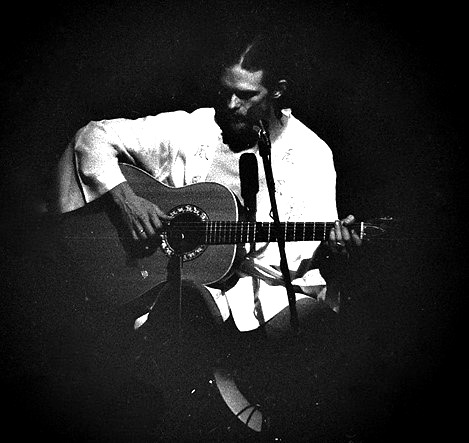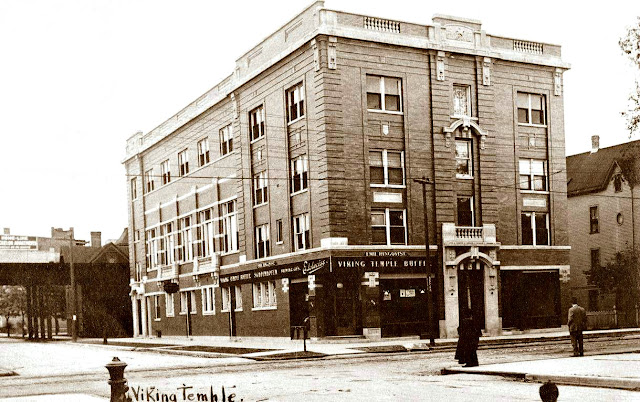The Lake View Beats
image - Chicagoan
image - Chicagoan
We begin this post with a music venue that was popular during the Great Depression of the 1930's when a couples that would
'marathon dance' for money and prizes just to survive.
established in 1921
a pocket mirror - Ebay
The Merry 'Dance' Gardens on the left with its neon sign
with the Victoria (Vic) Theater to the right
This establishment opened on Labor Day 1921 at 3136 N Sheffield. This venue was built by
Ethel Kendal and Jack Lund and survived for 31 years. After that the building
became a warehouse and then in 1961 it was demolished becoming a parking lot to much later condos
The Merry 'Dance' Gardens on the left with its neon sign
with the Victoria (Vic) Theater to the right
The location was once a 'Oak Grove'
called
By this time the (Howard) Redline was established by 1900.
The (Victoria Theater) Vic was constructed in 1912 along with the longest continuous business in Lake View - Anderson Brothers
Storage Warehouse (since 2013 lofts for residential use)
a zoomed view below
matchbook - Chuckman Collection
The Place to Dance in 1928
from Chicago Daily Tribune:
1928
1929
1930The dance marathon
photography by G.E. Thornrose Jr.
a year after the market crash of 1929
if you fell you were out of the competition
2690 hours of dancing in 1930
part of my collection
that highlights the second building to the south
Replaced by a Parking Lot by 1961
Replaced by a Parking Lot by 1961
photo - Theater Historical Society of America
1923 Sanborn Fire Insurance Map
1332 W Irving Park Road
the apparently the second location on Irving Park Road just west of Clark Street
The Orphei Singing Club was a Swedish-American social
club that featured singing, gambling, wrestling, and an art gallery. It was
also used to host social events. The club purchased a building at 1332 W.
Irving Park Road approximately by 1930. [prior location unknown]
Founded in 1910 per this article
matchbook - Ebay
a gift from Rizal Center for my collectioin
article from 1975
.jpg)



a gift from Rizal Center for my collectioin
According to Forgotten Chicago, the Orphei Singing Club was a Swedish-American social
club that featured singing, gambling, wrestling, and an art gallery. It was
also used to host social events. The club purchased a building at 1332 W.
Irving Park Road approximately 1930 (though it is unclear whether the purchase
of the building signals the start of the club or whether it was already in
existence). The club was also listed by Cook County as a tax-exempt
organization in April 1943. The club disbanded by 1974.The singing organization apparently had a building, a
possible social hall, on somewhere on School Street prior to 1930-ish.
624 Wrightwood Avenue
District of Lake View
photo - History of Swedes in Illinois
The present organization known
as the Svithiod Singing Club is the outgrowth of a male chorus formed in 1882
among the early members of the Independent Order of Svithiod It was directed
successively by Björnholzt E Becker August Elfåker and others. On Feb 11, 1893
the chorus was organized under its present name.
matchbook - Ebay
1923 Sanborn Fire Insurance Map
The
Quiet Knight
953 W Belmont Avenue
Join the conversation on Forgotten Chicago-Facebook!

1975 ad
The owner of the Quiet Knight
Richard Harding
'The effervescent owner of the Quiet Knight was the first to bring Bruce Springsteen and the E Street Band, the Talking Heads and Jimmy Buffett to Chicago. He loved Bob Marley as much as he loved Miles Davis.' - Daily Swarm



1975 ad
This venue was located 953 W Belmont Avenue/Sheffield between the
years 1969-1979 on the second floor of a vintage and still existing building on
the corner of Belmont and Sheffield, a very short walk from the Belmont Station
L stop This night club would entertain music personalities such as The Velvet
Underground, Muddy Waters, Bob Marley, Mike Jaggar & The Rolling Stones,
John Prine, Kris Kristofferson, and Steve Goodman.
Miles Davis in 1971
.jpg)
Rita Coolidge paid a visit in 1972
image - Obit of the Day

35mm Camera Original Negatives - Ebay
Shawn Phillips at Quiet Knight in 1973
photo - ceebop via Flickr
'Richard Harding’s club, The Quiet Knight, was only open
from 1969 to 1979. But during that decade the 400-seat concert venue saw of the
biggest names in music whether it was rock, jazz, or reggae. Located at 953
West Belmont in Chicago’s Lakeview neighborhood, The Quiet Knight occupied the
second floor of an otherwise non-descript brick building; but what went on
inside was music history. Herbie Hancock, John Denver, Linda Ronstadt (backed
by Don Henley and Glenn Frey), Bob Marley, Arlo Guthrie, Muddy Waters and
Loudon Wainwright all made appearances at the Knight. Bruce Springsteen and the
E Street Band first performed in Chicago in Harding’s club. Jimmy Buffett
performed outside of the South for the first time at the Knight.'
Listen to Bob Marley performance in 1975
images - Ebay
Muddy Waters in 1978
co-starring with The Rolling Stones
35mm Camera Original Negatives - Ebay
Venues
after Quiet Knight:
(same location)
Tuts Chicago
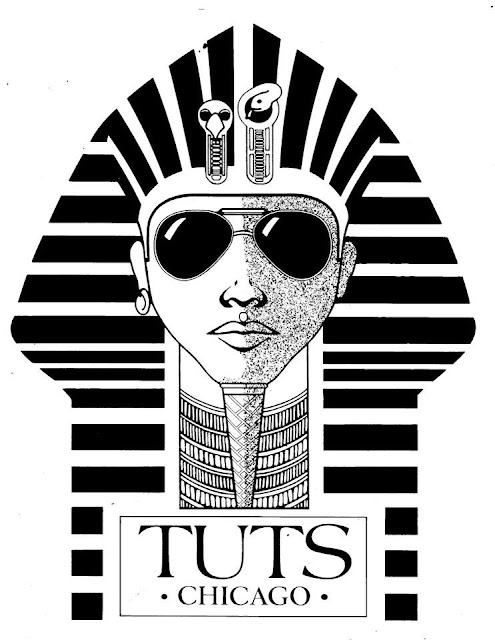



Avalon Night Club

first at 3730 N Clark Street
and then at 959 Belmont Avenue
photos - Ebaya performance in 1984


(click on article to enlarge)

images - Calumet 412
View more photos from the retro Facebook page
959 W. Belmont Avenue 1986-1994

image above - Avalon Nite Club-Facebook
same building as the Quiet Knight and Tuts
1987 article: 'The ghosts of the Quiet Knight and Tuts have long since
departed the premises. In their wake has arisen a comfortable neighborhood club
called Avalon night club.'
view west vs view east along Belmont
photos - Scotty Brown via Avalon Nite Club-Facebook
photo - Avalon Nite Club-Facebook
View more photos of this night club on Facebook
1980 ad - via Lethal Amounts
Echo & The Bunnymen at Tuts 1981
3530 N Clark Street
1980 ad - via Lethal Amounts
Echo & The Bunnymen at Tuts 1981
According to Christina Sybil Cary from Forgotten
Chicago-Facebook,” It's was The Quiet Knight first then it became Tuts. Groups
like the Echo & The Bunnymen, The Cramps & Bauhaus were notable bands
that played there.The Punk Club played there when the
space was called Avalon.
the night club closed in 1995
The Evolution to the
Chicago Punk Scene
The Reader by Leor Galil
My thanks to Carter O'Brien
for bringing this article to my attention
The Reader by Leor Galil
My thanks to Carter O'Brien
for bringing this article to my attention
"Punkin' Donuts didn't just attract folks from the Aetna park and Medusa's. Many regulars spilled out of other nearby venues: Tuts, a small rock club at 959 W. Belmont, had hosted an up-and-coming Bruce Springsteen in its previous incarnation as the Quiet Knight, and in 1987 it was replaced by the Avalon. Queer cabaret-inspired "video bar" Berlin opened in 1983 across the street from Tuts at 954 W. Belmont. Less than a mile north, you could see punk shows in the early 80's at Cubby Bear and Metro, some of them booked by Duffy. Punkin' Donuts pulled in characters from all those places, creating what Roman calls "a weird mix of family and fun."
A Cubs crowd during the day punkers at night
watch this 1984 video from above link
The Wild Hare 3530 N Clark Street
The “Wild Hare and Singing Armadillo Frog Sanctuary,”
(Wild Hare, for short) has been one of the premier reggae clubs in the country
since 1986. While nearby bars like Exodus II, B.L.U.E.S., and even the
Underground Wonder Bar offer excellent reggae bands, the Wild Hare edges them
out with their variety of national and international acts, music seven nights a
week, and a huge space to groove in. Run by Jamaicans and financed by venture
capitalists (prior to the dot-com rise and fall), the Wild Hare is sure to
appease anyone looking for a bit of Jamaica in the heart of the Wrigleyville. - Chicago Bar Project
 In 1986 they rented the nightclub from the federal
government, which had seized it after a series of drug raids. “My partners and
I have nothing to do with the old owners,” says Murray. “Yes, it was a reggae
bar called the Wild Hare. But that’s where the similarities end. We approached
the federal marshal and offered to reopen the club with a promise to keep it
drug free and problem free. We went through a probation period of one year. We
were under intense surveillance by the feds, who did not cite us for any
violations. We bought the club in 1987, and we have had very few problems with
most of our neighbors.” Their opponents do not agree. “There have been noise
complaints about the Wild Hare almost since the new owners took over,” says
Terri Hanley, president of Hawthorne Neighbors, a local community group. “They
are not the only bar in the area that is loud. But they are one of the few that
remain noisy even after we ask them to turn down the sound.” - Chicago Reader
In 1986 they rented the nightclub from the federal
government, which had seized it after a series of drug raids. “My partners and
I have nothing to do with the old owners,” says Murray. “Yes, it was a reggae
bar called the Wild Hare. But that’s where the similarities end. We approached
the federal marshal and offered to reopen the club with a promise to keep it
drug free and problem free. We went through a probation period of one year. We
were under intense surveillance by the feds, who did not cite us for any
violations. We bought the club in 1987, and we have had very few problems with
most of our neighbors.” Their opponents do not agree. “There have been noise
complaints about the Wild Hare almost since the new owners took over,” says
Terri Hanley, president of Hawthorne Neighbors, a local community group. “They
are not the only bar in the area that is loud. But they are one of the few that
remain noisy even after we ask them to turn down the sound.” - Chicago Reader3257 N Sheffield
1982-1991
1982-1991
by TimeOut editors and Joel Reese,
complied by Laura
Baginski 2014
'The place that made the Belmont/Clark
corridor a goth haven, this club was birthed by Dave Shelton in the early 1980's
on the corner of Sheffield and School. It opened its doors for all ages from
7:30-10:30 pm, before the dance owls swooped in until 3 am, at which point each
night the speakers blasted the grinding synths of Severed Heads' "Dead
Eyes Open" as a farewell alarm. The nascent Smashing Pumpkins took the
stage here in black capes, as did much of the local industrial scene. It may
have closed in 1992, but you can still buy black leather and spikes on Belmont.' - Laura Baginski
At first, Medusa’s was just for adults over 18. But after
a couple of years, Shelton kept getting requests from teens to offer an
all-ages night, according to Fields. So starting in 1986, Medusa’s started
offering all-ages nights until 11 o’clock on Saturdays.
Above is Medusa's when it housed the Japanese American
Service Committee. Before that, it was the Viking temple, a
Swedish social club according to Matthew Nickerson,
author of two books on the history of Lake View.
author of two books on the history of Lake View.
1910 postcard of Swedish Viking Temple
that apparently had a buffet on the ground floor
that apparently had a buffet on the ground floor
postcard - Chuckman Collection
Another Perspective
by Chicago Magazine/Arts & Culture
great article with lots of photos by Mike Thomas



photo - Peter Marchionna



by Chicago Magazine/Arts & Culture
great article with lots of photos by Mike Thomas
"Billing itself as a “juice bar,” the cavernous Lake View
club sold no alcohol (there were convenience stores for that) and it stayed open
until the dancing stopped, which was often mid-morning the next day. Its teen
dance parties, which increasingly became the club’s focus in its later years,
were a rite of passage for a generation of high schoolers, and the music was as
eclectic as the clientele: funk, electronic, R&B, industrial, punk, ska,
house, even pop. Live bands were part of the mix, too—little-known artists
who’d go on to fame: Al Jourgensen, the Red Hot Chili Peppers, Billy Corgan,
the Violent Femmes, Front 242."
- from the linked article
photo - Peter Marchionna

image - Richard Ragnar Sammartino
via Forgotten Chicago-Facebook
James Kulevick via Original Chicago-Facebook
on the reverse side of the membership or ID cards were photos
Medusa's was this punkish rock
club that apparently galvanized urban & suburb
kids to this building at 3257 Sheffield Avenue once known as a social club for
Swedish immigrants during the turn of the 20th century. The well known Alley was nearby, a place to
'hang-out'
before and after club hours.
before and after club hours.
The Electronic Music
1984
via Jonathon Gilbert
Medusa's on Sheffield/Facebook
Nov/Dec 1986 booklet - Ebay
a notice indicating an issue on the hours of operation
image - Ebay
Hear the sights and sounds of the
at the Vic Theatre
3145 N Sheffield Avenue
This 'nightclub-within-a-nightclub' opened in 1986 within the Vic Theater. The Chicago Tribune wrote that "If Clubland is just a nightclub, then Earth is a mere ball of dirt."
photo - Donna Joyce, 1975 with sign on building lower left
Forgotten Chicago on Facebook
first on Belmont Avenue
and then Halsted Street
t-shirt - Ebay
'In the club's early days, B.L.U.E.S. featured
predominantly local bluesmen and only charged $1 cover on Fridays and
Saturdays. According to David Grazian in his book, Blue Chicago (2003),
musicians also shared from proceeds collected in a blue-painted troll made from
papier-mâché, with a long tail and a hole in its head for contributions. The
much larger Kingston Mines, originally on Lincoln then on Clark, moved across
the street in February 1982, which had B.L.U.E.S. owners nervous until it
tripled their revenues and added legitimacy to both operations and clientele
synergy as it's impossible to go to one and not notice, or want to go, to the
other. As such, both clubs became more well known around the city and to
suburbanites, conventioneers and tourists from around the world who learned of
the place through hotel concierges and write ups in numerous publications,
including Esquire Magazine. Such popularity led to a second location in 1987,
called B.L.U.E.S. Etcetera, which lasted until 1999 at 1122 (or 1124) W.
Belmont and later become the now-defunct club, Lithium, until a new condo
building went up in its place.' - Chicago Bar Project
Celebrate 10 Years
in 1989
After location
on Belmont Avenue
The Metrophoto - Erin Kuchinsky via LakeView Historical-Facebook
the first location was apparently at 2519 Halsted Street
photo below - Tom Albanse
opened in 1927as a
Swedish Community Center
called
Northside Auditorium Building
when Swedish was the language of choice
when Swedish was the language of choice
photo below - Paul Goblet via Growing up in Chicago
1950 Sanborn Fire Insurance Map
zoomed view


from Forgotten Chicago-Facebook
This venue was establishment in 1982
Northside Auditorium 1943
Metro was once known as the Cabaret Metro,
and housed Stages Music Hall, and then the Smart BarNorthside Auditorium 1943
While the benchmark for success has changed over the
years at Metro, the ideology has remained stalwart. Cross platforms; break
boundaries; and pool talent from the local, regional and national levels. Local
H took the stage with Nirvana’s groundbreaking set still settling into the
stage’s grooves. Elliott Smith’s Chicago swan song rang through the building in
the same month as
Sleater-Kinney’s fiery feminist punk - Metro

Punkers Revisited
in 2023
The House Music Beat
photo from their Facebook page
House music (various tunes) was developed in the houses, garages and clubs of Chicago initially for local club-goers in the "underground" club scenes, rather than for widespread commercial release. As a result, the recordings were much more conceptual, longer than the music usually played on commercial radio. House musicians used analog synthesizers and sequencers to create and arrange the electronic elements combining live traditional instruments and percussion and soulful vocals with pre-programmed electronic synthesizers and "beat-boxes".
the building in 1926
Once located 3152 N Halsted & 3161 N Clark in a Spanish style building that was once one of the first Buick dealership in Chicago
1950 Sanborn Fire Insurance Map
According to former D.J Michael Ezebukwu “Back then
Chicago was full of clubs. It was Den One; it was the Ritz; there was Le Pub,
Broadway Limited, & Blinkers. For true house music, Club LaRay was a hot ticket. However, it was common for us to sit around and complain about what LaRay could do better. In retrospect, he did the best with what he had which, considering the clientele was mostly black, gay men, was impressive. That dynamic doesn’t even exist today in Chicago. There was often a healthy helping of women, straight folks, and minor celebrities in attendance, on any given night. - Read more from the title link above.
once located at
3435 N Sheffield Avenue
currently in Roscoe Village
once located at
Links Hall Studio building had always been called Link's Hall, named for
John J. Link, a dentist who built it in 1914 and emblazoned his name in the
plaster above the front door. That same year Weegham Park was constructed on Clark and Addison.
In 1978, long before a line of glitzy bars
frequented by tourists and sports fans erupted at the intersection of
Sheffield, Newport, and Clark, choreographers Bob Eisen, Carol Bobrow, and
Charlie Vernon founded Links Hall. Links Hall was an empty room above a
hamburger joint next to a women's health organization and a Japanese culture
center in a seedy neighborhood where the Red Line rattled by every few minutes.
Links Hall was a rehearsal space with shows at night: poetry readings,
experimental music, performance art, dance. Exploratory musician Michael
Zerang, an accompanist at MoMing who frequently rehearsed at Links, was the
first to curate a performance series there and became de facto artistic
director from 1985 to 1988. "Friday and Saturday nights were sitting
empty," he recalls. "Bob said, 'Do what you want.' I said, 'I do
music,' and he said, 'Fine.'" Nurturing the growth of the artistic
community is a holistic process at Links. Artists developing work receive not
only space and a high percentage of box office returns but mentor-ship from the
Links staff, and other, less tangible forms of support. "The artists and
the art have sustained Links, and Links supports not only the product but the
process," says Felicia Holman, director of Linkage partnerships, Links
Hall's in-kind partnerships with other organizations. This organization is
currently on Western Avenue.
– Reader 2019
There is a Link Studio Archive posted in Explore Chicago Collection of performances from 1987-1990.
Pops for Champagneonce located at
2934 N. Sheffield Avenue
currently located in the Loop
Above 2 photos - Ebay
along with a listing of other night clubs in the area
text - Rough Guide to Chicago
A Classical This so-called 'sophisticated jazz club' was established in 1982 and was once located at 2934 N. Sheffield Avenue is currently no longer in the hood. This establishment at this location offered "hundreds kind of champagnes" to its live-jazz loving patrons. I wish I had some interior photos - just say'in. Pops also owned Starbar, a bar aimed at a younger crowd; a cheaper alternative to Pops.
Pops for Champagne easily has the largest selection of
bubbly in the Midwest, and it has been so since the bar opened in March 1982
when owner Tom Verhey hired Chicago architect John Nelson to convert what was a
Lakeview grocery store into a champagne bar featuring 13 champagnes and a
limited bar menu. The idea came to him after visiting Reiss’ Champagne Bar in
Vienna while working as a salesman for Bell & Howell. In August 1986, the
property next door was acquired and transformed into a jazz club, again designed
by Nelson, while the original space was converted into Star Bar. All of the
above is particularly impressive considering that the neighborhood was rough
and gang-ridden back then, and Pops for Champagne has certainly had a
transformative effect on the neighborhood. - Chicago Bar Project
Music Venue:
The Lakeview Orchestra
The Lakeview Orchestra
This fifty-person symphony orchestra broke off from
Lakeside Pride Music Ensemble, a non-profit aiming to bring together the LGBT
community through music, a few months ago. And from goals for more concerts and
more practice to dreaming up ways to convert more people to classical music,
the Lakeview Orchestra wants to focus less on the social activism and more on
the music - DNAinfo

Lakeview Orchestra is Chicago's newest community
orchestra and has been hailed for 'committed and energetic performances' according to Chicago Classic Review in 2014.
Founded in 2013, this orchestra
is dedicated to engaging and entertaining audiences through compelling
performances.
Lakeview Orchestra presents more concerts each year than any
other community orchestra in Chicago, and regularly combines the orchestral
repertoire with interdisciplinary presentations such as dance, video, and
theater.' - their website
a dress rehearsal at Nettelhorst Elementary in 2015
The
players never don tuxedos, the program never includes an intermission, and the
orchestra never plays alone. The Lakeview Orchestra, a young neighborhood
ensemble in Chicago, depart from the traditional orchestral model while still
presenting serious, high-quality classical music - Your Classical
A Precursor Group
Formed in 1929
Performing at their Home Turf
in 2022
Is Medussa's back in
Lake View??
A old hang-out ...
A Musician's Hangout: just because
Jim's Diner
1429 W Irving Park Road
(the last location)
More about
Medusa's
a scholarly report
Please follow me to my next post called
by Christiane Feldman-Barrett via Carter O'Brien
(click to enlarge or link above)
These posts are exclusively used for educational
purposes. I do not wish to gain monetary profit from this blog nor should
anyone else without permission for the original source - thanks!



























